January 1, 2013 Water Supply Forecast Discussion
The CBRFC geographic forecast area includes the Upper Colorado River Basin,
Lower Colorado River Basin, and Eastern Great Basin.
Seasonal Water Supply Forecasts:
Below average spring and summer April-July streamflow volumes are forecast throughout the
Upper Colorado River Basin and Great Basin. Below to near median January-May volumes are
expected in the Lower Colorado River Basin.
The highest runoff volumes relative to average are expected in the Great Basin of northern Utah
and Green River Basin of southeast Utah. Lowest volumes relative to average are forecast for the
Gunnison and San Juan Basins. In the Lower Colorado River Basin highest volumes relative to median
are expected in the Verde Basin with lowest volumes in the Gila Basin
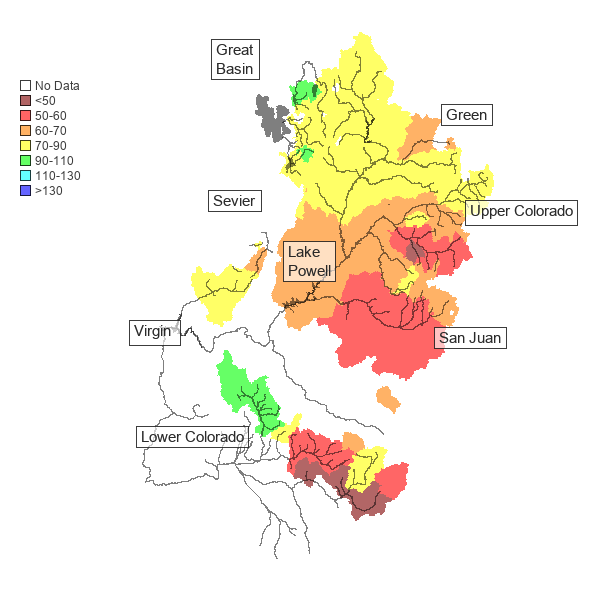 Click here for specific site water supply forecasts
Click here for specific site water supply forecasts
Water Supply Discussion
Weather Synopsis:
The weather pattern during the October-November period resulted in storms affecting the very
northern parts of the forecast are including the northern Great Basin in Utah and Green River
Basin of Wyoming. Minimal precipitation occurring throughout the Upper Colorado River Basin and
Lower Colorado River Basin.
During the first half of December a west to northwest flow developed over the forecast area.
This progressive weather pattern allowed frequent storms to move through the western U.S. and brought
widespread precipitation to the forecast area. The orientation of the storms and their associated
wind patterns were most favorable to the Great Basin, the Upper Colorado Basin north of the Gunnison
River Basin,and the Lower Colorado Basin with the exception of the Gila River Basin.
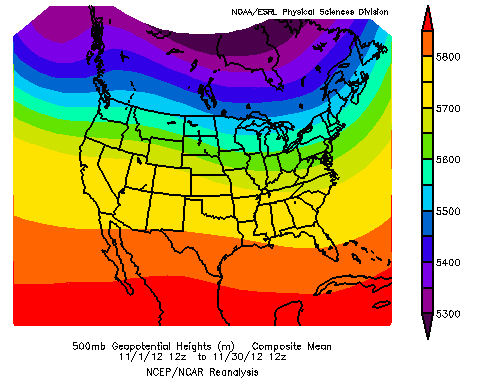
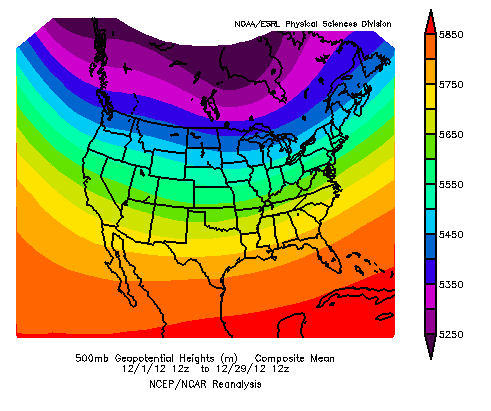
Image: Mean upper air pattern over the continental U.S. for November and December 2012
Precipitation and Temperature:
Very dry conditions were prevalent over the majority of the forecast area during October and
November. Exceptions to this were in the Bear and Weber Basins of northern Utah and the Green
River Basin of southwest Wyoming. A four day storm during the last week of October resulted
in monthly precipitation amounts near or above average for these areas.
In December the majority of the forecast area benefited from near to above average precipitation due
to an active weather pattern. Areas that didn't fair so well included the San Juan Basin, the upper
Gunnison River Basin, and the upper Gila River Basin where below average precipitation was observed.
Only sections of the Great Basin in northern and western Utah and the upper Green River Basin in Wyoming
have seasonal (October-December) precipitation values near or above average with very dry conditions
elsewhere.
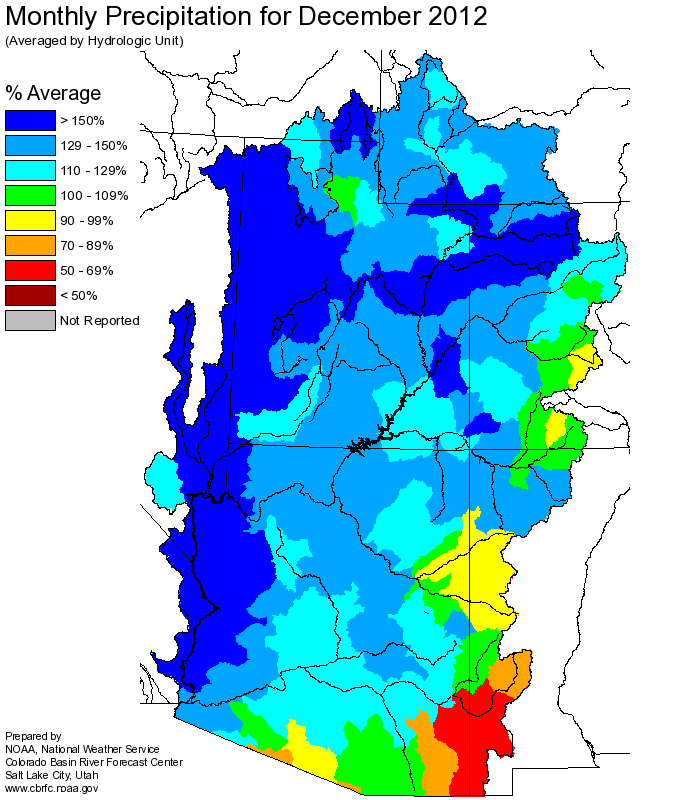
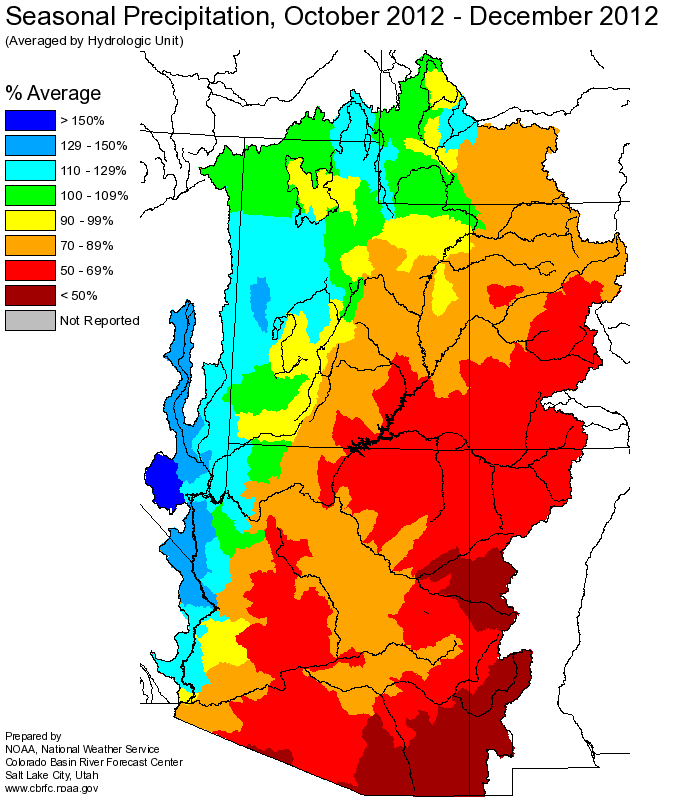
Temperatures were above average during the October-November period. Rain was observed at elevations
above 10,000 feet during times that are typically a snow accumulation period. This has resulted in
less snow at these higher elevations and is reflected in the forecasts.
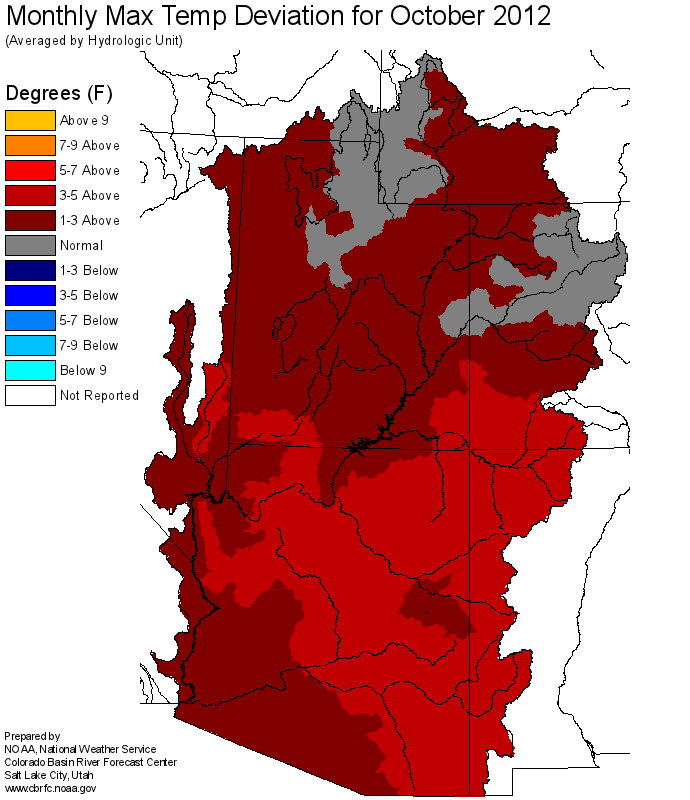
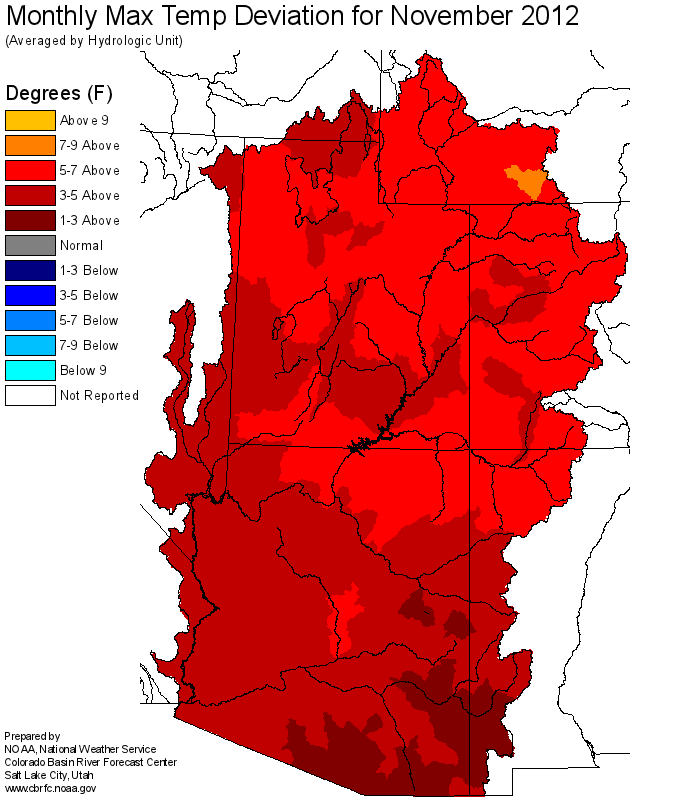 Snowpack:
Snowpack:
Snow conditions in early January deteriorate moving west to east across the forecast area. Snow
Water Equivalent (SWE) values are a mixed bag in the Great and Green River Basins within Utah and
Wyoming. Most SNOTEL sites in these areas indicate near or above average SWE. However there are also
several sites in this area with much below average SWE. Elevation and aspect of a location were important
factors in how much snow was received. This type of snow distribution is not uncommon with the type of
weather pattern experienced in December.
Much below average snow conditions exist throughout Colorado with the worst conditions extending
from the Roaring Fork, Blue, and Eagle River Basins (that feed the Colorado River mainstem) south
through the Gunnison and San Juan Basins.
The best conditions relative to average exist in the Lower Colorado River Basin including the Virgin
River, Verde, and Salt River Basins. The SWE drops to below average in the upper Gila Basin.
The map below is a display of SWE at SNOTEL sites as a percent of the 1981-2010 average.


Image: CBRFC Snow Conditions Map as a percent of average
Some SWE values in the Roaring Fork, Blue,and Eagle River Basins are the lowest for their respective
periods of record (red sites on the map below). Several other sites are in the bottom 10 percent of
record (orange on the map). Most SNOTEL sites in this area have periods of record around 30 to 35 years
so they rank near the 2nd or 3rd lowest for this time of year.

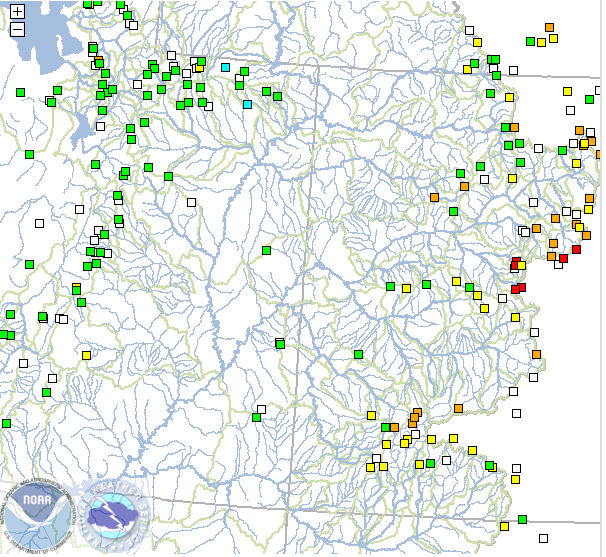
Image: CBRFC Snow Percentile Map - sites ranked based on historical record
Click here for river basin snow plots
Soil Moisture:
Soil moisture conditions in the higher elevation headwater areas are important entering the winter,
prior to snowfall, as it influences the efficiency of the snow melt runoff. Modeled soil moisture
conditions were below average througout the upper and lower Colorado Basins. In northern Utah modeled
soil moisture was closer to average in parts of the Bear, Weber, Provo, Six Creeks, and Duchesne Basins
due to the late October storm and high elevation rainfall. This is also true for some of the upper Green
River Basin headwaters in Wyoming. The generally dry soil moisture conditions elsewhere have influenced
the latest water supply forecasts. See the map below for a more detailed view.
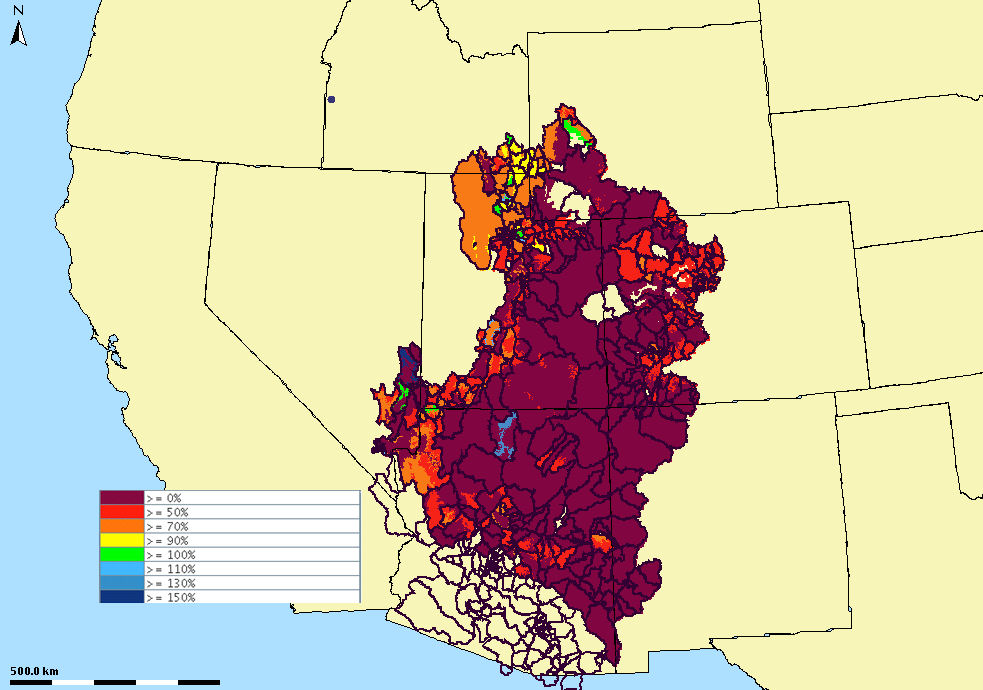
Image: Modeled soil moisture states (as a percent of average) on Dec 31 2012
Streamflow:
Monthly streamflow volumes throughout the fall months as well as during December have generally been
below average due to the dry conditions that extend back to the spring of 2012. December streamflow
volumes were closest to average in the Bear River Basin of northern Utah most likely due to rainfall
received during the fall
Climate Outlook:
The El Nino Southern Oscillation (ENSO) condition is considered neutral and this is expected to continue
through the spring months. The Climate Prediction Center indicates increased chances for below average
precipitation during the January-March period over the southern half of the forecast area, especially over
the upper Gila River Basin.
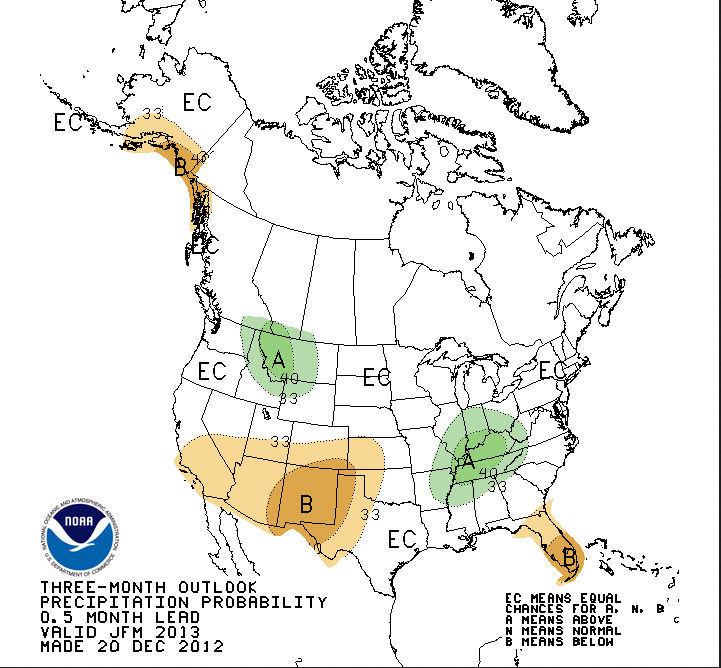
Image: Climate Prediction Center 3 month precipitation outlook
Conclusion:
Near record low runoff volumes occurred in the spring of 2012 across much of the forecast area. Very dry
conditions with much below average precipitation occurred over most of the area during the September through
November period. This has resluted in much below average modeled soil moisture conditions.
Mild temperatures during the fall also resulted in rainfall with initial storms instead of accumulating snow
at higher elevations. Snow is generally much below average throughout the forecast area with exception of the
Lower Colorado Basin and parts of the Great and Green Basin.As a result streamflow volumes are forecast to be
below to much below average as of January 1st.
End Of Month Reservoir Content Tables
Green River Basin
Upper Colorado River Basin
San Juan River Basin
Great Salt Lake Basin
Sevier Basin
Lower Colorado Basin
Basin Conditons and Summary Graphics
Green River Basin
Upper Colorado River Basin
San Juan River Basin
Great Salt Lake Basin
Sevier River Basin
Lower Colorado Basin
Definitions
10% exceedance forecast: Given the current hydrometeorological conditions, i.e current snowpack, soil moisture and streamflow, the volume that has a 10% chance of being exceeded. Previously referred to as "Reasonable Maximum Forecast".
50% exceedance forecast: Given the current hydrometeorological conditions, i.e current snowpack, soil moisture and streamflow, the volume that has a 50% chance of being exceeded. Previously referred to as "Most Probable Forecast".
90% exceedance forecast: Given the current hydrometeorological conditions, i.e current snowpack, soil moisture and streamflow, the volume that has a 90% chance of being exceeded. Previously referred to as "Reasonable Minimum Forecast".
Acre-Foot (af):
The volume equal to one acre covered one foot deep (43,560 cubic feet). See kaf below.
Average:
The arithmetic mean. The sum of the values divided by the number of values. Values from 1981-2010 are used for this publication.
Categories:
Much Above Average=Greater than 130%, Above Average=111-130%, Near Average=90-110%, Below Average=70-89%, Much Below Average=Less than 70%.
CBRFC:
Colorado Basin River Forecast Center.
Forecast Period:
The period from April 1 through July 31, unless otherwise noted.
kaf:
Thousand Acre-Feet. See Acre-Foot above.
Inflow:
The volume of water that flows into a reservoir or lake.
Median:
The middle value of an ordered set of values. Half of the values are higher and half of the values are lower. When the set contains an even number of values the median is the average of the two middle numbers.
NOAA:
National Oceanic and Atomospheric Administration.
NWS:
National Weather Service.
Rounding Conventions:
| Range | | Round to |
| 0-1.99 | | 0.01 |
| 2.0-19.9 | | 0.1 |
| 20-199 | | 1.0 |
| 200-999 | | 5.0 |
| 1000+ | | 3 significant digits |
Streamflow:
The volume of water that flows past a specific stream site.
Water Year:
The 12-month period, October 1 through September 30. The water year is designated by the calendar year in which it ends. Thus, the year ending September 30, 2008, is called the "2008 water year."
Additional Information
Water supply forecasts take into consideration present hydrometeorological conditions and use
average basin temperatures and precipitation for the forecast period. As the forecast season progresses,
a greater portion of the future hydrologic and climatic uncertainty becomes known and
monthly forecasts become more accurate. For more information on the tools we use, consult
Water Supply Forecasting Tools.
Volume forecasts represent adjusted flows; that is, observed flows with upstream water use
taken into account. Adjusted flows will closely approximate natural or unimpaired flows.
However, not all upstream diversions or impoundments are measured or quantifiable. For specific
adjustments used with each forecast point, consult the
Guide to Water Supply Forecasting.
The Water Supply Outlook is issued monthly January through May by the Colorado Basin River
Forecast Center. It represents a coordinated effort between the
National Weather Service, Natural Resources Conservation Service, Bureau of Reclamation, U.S.
Geological Survey and local water district managers.
Note: Data used in this report are provisional and are subject to revision.
For more information, or to be included on the mailing list, please contact:
Colorado Basin River Forecast Center
2242 W North Temple
Salt Lake City, UT 84116
(801) 524-5130
www.cbrfc.noaa.gov












